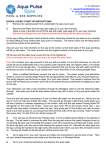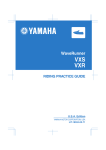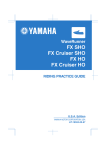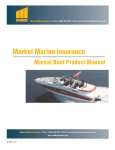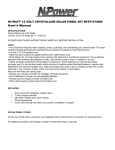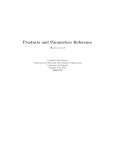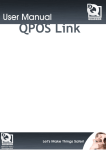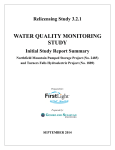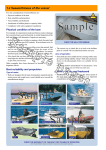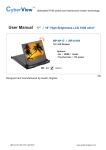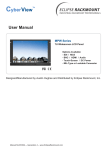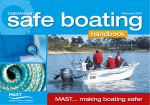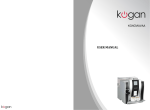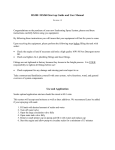Download Section 7 - Gold Coast Boat and Jet Ski Licensing
Transcript
7.0 Personal watercraft Types of PWC There are two main types of PWC: 7.1 Licensing It is compulsory for all PWC operators to hold a personal watercraft licence (PWCL), a separate licence from the recreational marine driver licence (RMDL). To obtain a PWCL applicants must first hold an RMDL or commercial marine qualification as a master. There is no minimum time required to hold a RMDL before obtaining a PWCL. If you move from interstate, you are required to obtain a PWCL unless you hold an equivalent PWCL issued by another state. Short-term visitors can use their boat licence equivalent, if that is all that is required to operate a PWC in their home state. You can operate a PWC without a licence only if accompanied by a licensed operator who is able to take immediate control of the craft if required. A PWC hired from a licensed PWC hirer can sometimes be ridden without a licence under their special restrictions which must be stated before the hirer operates the PWC. 7.2 Preparation Language Personal watercraft All PWCL applicants must undertake a competency-based training program (BoatSafe) for personal watercraft operations before being eligible for a licence. Performance-orientated PWC (stand-up): Featuring a hinged, adjustable steering column, the rider stands or kneels on a platform at the stern of the boat. These are often used for racing, and require skill and balance to operate. They can accommodate only one rider. BoatSafe Workbook Personal watercraft (PWC) are small, high-powered inboard jet-driven boats, capable of high speeds and radical manoeuvres. The risk of a marine incident or injury to riders, passengers and other water users is dramatically increased due to these factors, particularly if the rider is unaware of the unique characteristics of PWC and are unskilled in their use. Cruising PWC (sit-astride): The most popular type, accommodating up to four people. Propulsion PWCs can use either a two-stroke (similar to many outboard motors) or a four-stroke engine (similar to a car engine). The engine drives a powerful water pump which sucks up water from the bottom of the craft through an intake grate. The water passes through an impeller, a type of propeller fitted into a surrounding ‘tunnel’, which pressurises the water and forces it out a jet nozzle (below) at the rear of the craft. 83 This jet of pressurised water propels and steers the craft when the throttle is engaged. Some newer PWC include ‘offthrottle steering technology’ which offers the craft limited manoeuvrability when the throttle is off. Registration • check if there is adequate fuel and oil for usage • check spark plugs and electrical systems for evidence of wear and tear or potential for electrical sparks • ensure that the intake grate is free of foreign objects • ensure all compartments and seats are secure. All PWC must be registered (see p. 16). PWC registration symbols must be: Check with the manufacturer’s user manual to find out if they advise starting the engine before the PWC is launched into the water, and for how long the engine should run. BoatSafe Workbook • • • • • displayed on both sides at least 100 mm high legible from 30 m clearly visible in a contrasting colour to your craft easily seen while your craft is under way. The registration label must be displayed on the port (above) side of your craft, adjacent to the registration symbols. Registration label Registration No. JS469Q Where possible, fuel your PWC on land rather than on the water to minimise the risk of polluting the waterways and to ensure the PWC is stable. Be responsible by regularly maintaining your fuel system, not overfilling your fuel tank, watching the breathers and using absorbent material to collect fuel overflow. Be sure to refuel in an open, ventilated area where there are no naked flames. Do not over-tighten the fuel cap. Personal watercraft Safety equipment 7.3 Pre-departure checks Routine maintenance Like any other boat, before taking your PWC out on the water, read and understand the owner’s manual. Take the time to become familiar with all aspects of your craft. In the event of breakdown PWC have no alternative propulsion such as oars or sail. It is therefore critical to inspect and maintain the craft to minimise the risk of engine or steering failure. Consult the manufacturer or dealer for a maintenance schedule. Before launching: 84 Fuel • check inside and under the hull to make sure there are no cracks and excessive wear and tear on the craft, including water leaks • secure bungs (shown right) • check steering and throttle for correct operation • check battery fluid level and charge condition PWC operators and passengers must wear a PFD at all times. The type of PFD and other safety equipment for PWC is dependent on where you are travelling. The table, on the next page, outlines the minimum equipment requirement set by legislation, and recommended equipment to satisfy the general safety obligation. Water limit maps starting on page 26 indicate the three designated water types along the Queensland coast. Consider your entire trip, including areas through which you are only traversing when equipping your PWC. See page 33 for a description of PFD types 2 and 3. A Ride Smart sticker (right) must be affixed to the PWC and visible to the operator at all times. Carry the minimum safety equipment, but to enhance safety, confidence and enjoyment consider carrying safety equipment to cater for the unexpected. For example, consider the following equipment: tow rope, spare bungs, spare lanyard, helmet, gloves and booties. Lanyard PWC have either an ignition safety switch or a self-circling feature if the operator falls off. Most cruising PWC come equipped with an emergency ignition safety switch. This is a safety device which is designed to shut the engine down if the operator is thrown from the proper operating position. Compulsory equipment for all PWCs operating in certain areas equipment smooth water partially smooth water EPIRB (Emergency Position Indicating Radio Beacon) PFDs/life jackets One of the appropriate size for each person. Ride Smart Label beyond smooth and partially smooth water all PWC (including non-registrable) operating in these limits when more than 2 nm from land PFD types 2 or 3, or a wetsuit with inbuilt flotation approved as PFD type 3 PFD types 2. PFD type 2. all PWC all PWC all PWC all PWC all PWC all PWC All PWC operating between sunset and sunrise. All PWC operating between sunset and sunrise. all PWCs operating between sunset and sunrise. Must be affixed to the PWC and visible to the operator at all times. Must be affixed to the PWC and visible to the operator at all times Signalling device For example: torch, fluorescent light, lantern and cyalume stick. Equipment recommended to satisfy the general safety obligation equipment Drinking water Sufficient for everyone on board for duration of trip. smooth water all PWC partially smooth water all PWC beyond smooth and partially smooth water all PWC Trailer launching and retrieval As with other boats, PWCs are commonly transferred to the water, launched and retrieved via a trailer (see page 46). If the operator is thrown from the operating position of a PWC with a self-circling safety feature, the engine will begin running at idle speed while the PWC slowly circles. The operator can then reboard. Be sure that the idle speed is always set correctly, and don’t swim after the circling PWC–it will come back to the fall-off position. Upon reboarding, be sure to re-attach the lanyard or the engine will not start. Always ensure that the lanyard is attached to the licensed operator who is in immediate control of the PWC. Test the lanyard is working before departing on your journey. Post-operation checks Check with the manufacturer’s user manual or dealer regarding recommended post-operation checks and maintenance. The success of your next trip and durability of your craft will depend on how you treat it after use. Personal watercraft 7.4 Manoeuvring The safety switch works by attaching a lanyard between the operator and the switch. It is attached either to the operator’s PFD (above left) or their wrist (above right). If the lanyard is removed from the switch, then the engine will shut off. BoatSafe Workbook Capacity Label It is possible to launch the PWC by either pushing it from the trailer manually, or if the stern is in sufficient water, applying the reverse lever to manoeuvre the PWC from the trailer under power. A bow line needs to be attached if the PWC is pushed off manually. Launching When launching from a river bank or sand bar, make sure the craft is well clear of other water users such as swimmers, and no swimmers are in the path of the boat once it has started. Be aware that a PWC puts out a water jet stream up to three metres which can cause injury to persons bathing. Point the bow of the craft to the centre of the waterway or away from shore into knee deep water (where sand will not be sucked into the intake grate). Rock the craft from side-toside to free the craft of sand and debris. Attach the lanyard and turn the ignition on. PWCs do not have a neutral gear. Once you start the motor, the craft will move forward. Maintain six knots or below until 60 m from the shore. 85 Landing Always allow plenty of room for stopping. Boats do not have brakes! From full speed, PWC can travel up to 80 m after the throttle is released and engine stopped. Practise stopping in the middle of a waterway to find out the stopping characteristics of the PWC, and how much water you will require to land the craft without damage. The reverse lever (see control at slow speed and reverse) can assist in landing. Those craft without a reverse lever can require a greater stopping distance. BoatSafe Workbook If landing on a beach or sandy shore, turning the engine off before entering shallow water prevents the engine sucking up sand through the intake grate and damaging the impeller. When beaching the PWC the speed should be less than six knots within 60 m of shore. A safe PWC operator would travel slower if the area has hazards such as rocks and concrete boat ramps. This connection between steerage and power is the most critical aspect to understand about operating a PWC and cannot be over-emphasised. Many accidents have occurred when a PWC operator has collided with objects or people after turning off the engine or reducing power. When confronted with an obstacle, many people’s reflex action is to take their thumb off the throttle; however, to take evasive action it is important to retain power and turn to either side. Practise turning at high speed in an open area without other boating traffic. Safe PWC operators always keep a proper lookout, anticipate hazards and know their boat’s capabilities. Personal watercraft Control at slow speed and reverse Most cruising-style PWC are very stable when stationary or when travelling at slow speed in smooth water. Stand-up craft at slow speed require more coordination and balance on the part of the rider. Steerage PWCs are jet-driven and do not normally have a conventional rudder. Rather, they have a steering nozzle at the back of the craft which is controlled by the handlebar. This nozzle directs the stream of pressurised water from left to the right. When the steering control is turned right, the steering nozzle is turned right. The force of the water leaving the nozzle pushes the back of the boat to the left, which causes the PWC to turn right. Water conditions (rough, smooth, currents), the rider’s body movement, and the number of passengers will all cause the PWC’s steering to respond differently. 86 Most importantly, a PWC must always be under power to maintain control. When the engine is idling or shut-off during operation, all steering control is lost. The PWC will continue in the direction it was headed no matter which way the steering control is turned (some PWC have a limited ‘offthrottle’ steering control). The three categories below will help understand how a PWC behaves at different speeds: Trolling is idle speed when little or no throttle is used. The bow of the PWC is down in the water and there is no wake. Sub-planing is medium speed. The bow of the PWC is out of the water, but the stern is forced deeper in the water which creates a larger wake. Control at speed PWC are designed for speed. Turning a PWC at a higher speed is like turning a motorcycle. Reduce speed slightly, turn the handlebars and shift your weight toward the direction of the turn. Apply sufficient throttle to complete the turn. The higher the thrust, the sharper the turn will be. Insufficient or no throttle may cause the PWC to turn slowly or not turn at all, while excessive throttle may cause the PWC to ‘spin out’, causing operator and/or passengers to be thrown from the PWC, or causing possible injury. BoatSafe Workbook Planing is a faster speed where the bow and the stern of the PWC are level. The entire craft is skimming on top of the water, which creates a minimal wake. When trolling or sub-planing, tighter manoeuvring and cornering are possible by ‘feathering’ the throttle (applying the throttle with short, sharp actions) while steering. It is important to understand that the reverse lever does not redirect the jet nozzle itself, but repositions the reverse bucket (shown right), redirecting the pressurised water jet. Therefore, the reverse lever should only be applied when the engine is in a slow idle. Doing so at higher speed can damage your craft. Avoid using the reverse lever as a brake. Once the reverse lever is in place, more speed can then be applied, but most PWCs travel at vastly slower speeds in reverse. The reverse lever (shown being applied below) is useful to assist in manoeuvring a PWC next to other stationary craft, structures such as jetties, when landing, or if picking a person out of the water. Rough water operations Operating a PWC at high speed in rough conditions, such as in choppy conditions, affects the steering, power and balance of the craft. If, after hitting a small wave, the craft becomes airborne, steering and power will momentarily stop. This will effectively reduce the straight line speed of the craft. The amount of fuel on board (the average PWC holds around 60 litres) is also a contributing factor to the performance of the craft in such conditions. Personal watercraft Most new model PWC have a reverse thrust to assist slowspeed manoeuvring. This is usually operated by a lever on the side of the cowling, which repositions a ‘reverse bucket’ over the jet nozzle, forcing the pressurised water jet to be redirected toward the front of the PWC. This makes the craft move backwards, with the steering assembly determining the direction. It is easy to fall off the PWC in choppy conditions and hard to reboard. Be sensible and reduce speed to match conditions. Extended high speed operation will affect muscle control in the arms and be exhausting. Rough water operation should only be conducted by experienced still water operators, and when possible, in the company of a second PWC. Passenger’s hold The safest way a passenger can secure themselves while riding a PWC is to hold the life jacket of the operator or the person immediately in front of them. Many personal flotaton devices made for PWC have specially designed straps on either side. Holding onto the handle at the back of the seating can lead to injury of the passenger arms or back in the event of a capsize or a spin-out. 87 Before riding at high speed, an operator should familiarise themselves how the steering of the craft alters when extra passengers are on board. The operator should also brief passengers on the capabilities of the PWC. The operator is responsible for the well-being of the passengers and should ensure all passengers are wearing a suitable personal flotation device. Freestyling BoatSafe Workbook Freestyling is erratic and non-directional driving, where it is difficult for others to predict your course. High speed manoeuvres such as wake-jumping, donuts, figure 8s, 360s and so on are examples of freestyling. It can be unsafe, annoying and noisy for other water users and nearby residents. When going out to sea, ensure the PWC meets the wave head-on, limiting the chances of rolling or broaching. When returning to shore, ride behind the wave, allowing water beneath the PWC at all times. Avoid riding the face of a wave with a PWC like a surfboard. If a PWC is caught by the lip of a wave, the craft can broach, leading to significant damage to the craft and rider. Use the throttle generously to avoid the crash zone, but also steer away from shallow water. When you are freestyling be aware of other water users. Find a place away from populated areas like beaches and residential areas. Distance-off laws apply to freestyling PWC operators (see ‘Distance and speed’ on page 87). PWC operators must obey speed limits (see speed limits on p.60). Personal watercraft If there is more than one craft freestyling in an area, operators should discuss and agree on a direction of operation, for example, anti-clockwise. Restrictions on where PWC may operate can be found in the Transport Operations (Maritime Safety) Regulation on the Maritime Safety Queensland website and waterways management plans and marine zones (see pages 90—91). Wave jumping and surf riding Wave jumping and surf riding can be dangerous for inexperienced or careless riders. Before wave jumping and surf riding check how many other water users are in the vicinity; like swimmers, board riders and other PWC. Operators should also be aware of hazards in the area, such as rocks, jetties and sandbars. A PWC rider must stay at least 60 m from bathing reserves (for example, flagged areas) and people in the water. It is best to avoid wave jumping in an area where there are swimmers. Avoid collisions and injuries by thinking carefully before jumping a wave. Note the location of other water users, think about the speed of the craft at take-off, the height of the wave, and approximately where the PWC will land. When jumping in larger waves, it is often difficult to see board riders or other water users below the crest of the wave. Be aware of sandbars in shallow waters and underneath waves. Make sure there is sufficient water to manoeuvre after the wave has subsided. 88 after a jump of several metres in the air. Injuries from such accidents are common. For this reason, inexperienced riders should first practise jumping at a slower speed over smaller waves, and slowly progress as skill and confidence increase. Once airborne, it is easy for inexperienced riders of PWC to become separated from their craft. This can lead to serious injury if the rider lands on the PWC itself or a sandbar Capsizing and righting Because of a low centre of gravity in their upright position, it is rare for a PWC to remain upturned after capsizing. Most manufacturers of PWC outline how to right the craft in the user’s manual. If you roll it over the wrong way, you could cause serious damage to your PWC or to yourself. The following is a typical way of righting your PWC: 1. Ensure the engine is stopped by removing the engine stop switch or lanyard. 2. Swim to the rear of the PWC and turn it over by gripping the ride plate with your left hand and pushing down on the gunwale rail with your right hand or right foot: • do not put your hand in the intake grille • take care not to be hit by the PWC as it turns over • if in rough water, observe the waves and avoid being near the PWC when waves approach. 3. Reboard the craft, start the engine and head for shore as soon as practicable to inspect the PWC for water damage. Falling off and reboarding If you have fallen off in deep water and the engine has cut off, reboard over the back deck (climbing on the side can capsize the boat). Most PWC have handles on the back of the seating assembly. Practise reboarding with someone else around to make sure you can handle it alone. Avoid riding when tired or injured as reboarding will be difficult. BoatSafe Workbook 60 metres • 60 m from people in the water • 60 m from anchored or moored boats, boat ramps, jetties or pontoons • 60 m from shore • 60 m from boundary of a bathing reserve. Learn how to judge distance, for example 60 m is 10 m longer than an Olympic-sized swimming pool. Great care should be taken when manoeuvring a PWC near a person in the water, keeping in mind that a jet nozzle can propel water up to three metres behind the craft. Injury can also occur if hair or clothing is caught in the intake grate. When the person in the water is close enough to swim toward the craft, turn off the engine. The person can then board from the back of the craft. 7.5 On the water All PWC users must know and abide by the IALA buoyage system, rules of the road, sound signals, navigation lights and local rules (see Chapter 4). Distance and speed For your safety and that of everyone else using the water, do not exceed set speed limits. Do not travel at speeds where your wash can cause damage to the shoreline, other boats or injury to others. Consider the density of traffic in the area to determine a safe speed. The following distances must be adhered to or reduce speed to 6 knots (= 11 km/h approx) within: • the waterway is less than 120 m wide, and o the PWC operator is operating the PWC as close as practicable to a straight line to transit the area o the PWC operator stays as close as is practicable to the centre of the waterway or a marked channel • the PWC is being used in waterskiing/towing. In coastal waters, freestyling or wave jumping is restricted to: • outside 200 m of the shore if dwellings are within 100 m of the shore line and visibile to the operator, and are in the vicinity of the waters where the PWC is operating. Coastal waters do not include dams and inland waters. Personal watercraft Picking up people from the water Exceptions apply to ‘6 knots within 60 m’ from the shore under the following conditions: Causes of PWC accidents Of all boat types registered in Queensland, PWC are involved in the highest percentage of incidents. To reduce the chance of incidents consider the following: • Do not ride too closely behind another PWC. A sharp turn by the leading PWC can lead to a collision. The rider of the leading PWC can be run over if they fall off. • Always look over both shoulders before making turns— another boat may be too close behind. • Do not zig-zag with another PWC at high speed. • Be aware of traffic in your boating area—don’t focus on the short distance ahead. • Do not reduce power to avoid an object. Keep power applied and turn away. • Do not ride or jump the wake of boats too closely. Oncoming traffic can be obscured from view by the boat, or the boat can stop or change direction suddenly. 89 • Stop the engine when someone is boarding from the back of the craft. • Reduce speed significantly in shallow water. Don’t go out alone Always attempt to ride in pairs, particularly when wave jumping or travelling in open waters. A mechanical breakdown can cause major trouble. A simple twisted wrist can reduce your ability to get yourself back to shore safely. BoatSafe Workbook In cases of real emergencies the second PWC can act as a rescue craft or at least go to get help. Always tell someone who is staying on land where you are going and when you expect to return. Communications Most PWC are not capable of carrying a standard marine radio. If travelling long distances or in open waters consider taking either a hand-held VHF radio or a mobile phone. Waterskiing Refer to the manufacturer’s manual of your own PWC for more detail on clearing the jet intake and impeller of debris. Courtesy Riding a PWC safely takes skill and a responsible attitude. Unfortunately some riders believe a PWC can be ridden anywhere and in any fashion without considering the consequences. To gain the most enjoyment from your PWC, ride where you can have fun but don’t annoy others. Don’t operate the PWC in a manner that could cause nuisance, annoyance or danger to people in the area. For example, where possible avoid manoeuvres that cause the engine exhaust to lift out of the water because it increases noise levels. Try to travel in areas where noise will not disturb other people or wildlife. In particular, try not to operate near houses, parks, populated beaches or boat ramps. Avoid shallow areas where wading birds congregate and roost. Remember your behaviour will reflect on all other PWC riders. Personal watercraft As an observer is required, cruising PWC seating two or more can be used for waterskiing. The same rules apply to PWC as to other boats involved in waterskiing (see page 63). Marine zones Noise and nuisance caused by these craft are the most common complaints about PWC. Cleaning jet intake and impeller The most common cause of breakdown while operating PWC is a blocked impeller. If weeds or debris get caught in the intake or impeller during operation, cavitation can occur. Cavitation is indicated by engine speed rising and the same time forward thrust decreasing. If this condition is allowed to continue the engine will overheat and may seize. If there is a significant loss of power, take your PWC to shore and check the intake and impeller. Always stop the engine before reaching land. If at sea, turn your PWC off and sit for at least five seconds and then restart the engine. If the intake is still clogged, stop the engine, dismount and reach under the PWC to remove the obstruction from the intake grate. 90 Before attempting to remove weeds or debris from the jet intake or impeller areas, shut off the engine and remove the engine lanyard from the stop switch. If this is unsuccessful, return to shore immediately. In areas where there are a large number of waterside residences, narrow stretches of navigable water and the waterway is used for other low impact activity (swimming, rowing and so on), excluding PWC from these areas through marine zones created under the Transport Operations (Marine Safety) Regulations 2004, may be the only feasible way of effectively managing the noise, amenity, safety and environmental impacts created by their use. Marine zones may be introduced in certain areas throughout the state, limiting a certain type of boat, for example PWC or hovercraft, or a certain type of activity, for example, freestyling, from an area. Before going out to ride, check whether your intended destination is a marine zone. Information about marine zones is available on the Maritime Safety Queensland website <www.msq.qld.gov.au>. The website also includes information about Waterways Management Plans, which show where freestyling is prohibited on the Gold and Sunshine Coasts. Also refer to the Department of Environment and Resource Management website <www.derm.qld.gov.au> for information about marine park zones and any other restrictions that may apply in these areas. In Queensland, PWCs have been prohibited in the waters of Tallebudgera Creek since 1997. Restrictions also apply for certain water-based activities on the Noosa River as part of the new Noosa River Marine Zone. The most significant changes apply to personal watercraft (PWC) activities, waterskiing, freestyling, hovercraft and airboats. Enforcement officers A dedicated PWC patrol team has been established within Maritime Safety Queensland. The team’s role is to: The Queensland Boating and Fishing Patrol and Water Police also enforce marine safety regulations. Personal watercraft • conduct on-water enforcement patrols targeting known PWC hot spots • conduct education days with marine studies students, PWC clubs and other boating associations • work with enforcement partners to ensure appropriate resource allocation to ensure good compliance outcomes • work with Councils in applying zoning assessment criteria and establishing an appropriate education and enforcement plan to accompany zone proposals. BoatSafe Workbook For more information on the Noosa River Marine Zone visit www.sunshinecoast.qld.gov.au. 91









